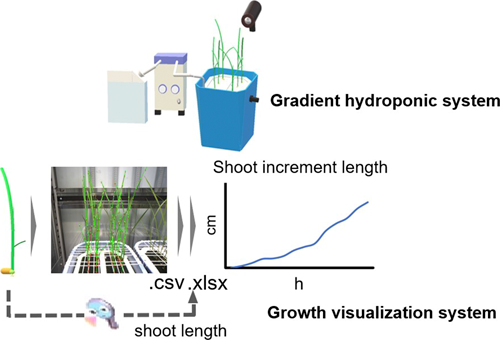- 著者
- Chihaya Fukai Takanari Tanabata Tomoko Nishizawa Mikiko Koizumi Keisuke Kutsuwada Miyako Kusano
- 出版者
- Japanese Society for Plant Biotechnology
- 雑誌
- Plant Biotechnology (ISSN:13424580)
- 巻号頁・発行日
- pp.22.1107a, (Released:2023-01-23)
- 参考文献数
- 22
Nitrogen (N) fertilization is one of the most crucial factors that contribute to increasing food production requiring the generation of rice cultivars with improved N use efficiency (NUE) to maintain yield during low N fertilizer application. To assay NUE extent, we developed a screening system to evaluate shoot growth of each rice cultivar under gradient changes in N concentrations. This system comprises a gradient hydroponic culture and growth visualization systems. The former allows gradient changes in ammonium concentrations, while the latter records the increment in shoot length of individual rice seedlings at given time periods using a fixed-point camera. We chose 69 cultivars including two controls (Oryza sativa L. cv. Nipponbare [WRC01] and Kasalath [WRC02]) from the World Rice Core Collection to investigate shoot growth responses under ammonium-sufficient, ammonium-limited, and low ammonium concentration gradients without transplanting stress. We observed three growth patterns in response to different ammonium concentrations. Subsequently, we selected three representative cultivars (Kasalath, WRC03, and WRC05) for the characteristic responses under the different ammonium environments. Distinct expression patterns of glutamine synthetase 1;2 (OsGS1;2) but OsGS1;1 were observed in response to varying ammonium concentration regimes, indicating that the expression patterns of OsGS1;2 may be a growth marker in terms of shoot growth when transitioning from ammonium-limited to low ammonium concentrations. This system with the level of OsGS1;2 allows us to screen for candidate cultivars that return high NUE in low N environments.
- 著者
- Naoya Sugi Quynh Thi Ngoc Le Makoto Kobayashi Miyako Kusano Hiroshi Shiba
- 出版者
- Japanese Society for Plant Biotechnology
- 雑誌
- Plant Biotechnology (ISSN:13424580)
- 巻号頁・発行日
- vol.38, no.1, pp.67-75, 2021-03-25 (Released:2021-03-25)
- 参考文献数
- 43
- 被引用文献数
- 4
Heterosis refers to the improved agronomic performance of F1 hybrids relative to their parents. Although this phenomenon is widely employed to increase biomass, yield, and stress tolerance of plants, the underlying molecular mechanisms remain unclear. To dissect the metabolic fluctuations derived from genomic and/or environmental differences contributing to the improved biomass of F1 hybrids relative to their parents, we optimized the growth condition for Arabidopsis thaliana F1 hybrids and their parents. Modest but statistically significant increase in the biomass of F1 hybrids was observed. Plant samples grown under the optimized condition were also utilized for integrated omics analysis to capture specific changes in the F1 hybrids. Metabolite profiling of F1 hybrids and parent plants was performed using gas chromatography-mass spectrometry. Among the detected 237 metabolites, 2-oxoglutarate (2-OG) and malate levels were lower and the level of aspartate was higher in the F1 hybrids than in each parent. In addition, microarray analysis revealed that there were 44 up-regulated and 12 down-regulated genes with more than 1.5-fold changes in expression levels in the F1 hybrid compared to each parent. Gene ontology (GO) analyses indicated that genes up-regulated in the F1 hybrids were largely related to organic nitrogen (N) process. Quantitative PCR verified that glutamine synthetase 2 (AtGLN2) was upregulated in the F1 hybrids, while other genes encoding enzymes in the GS-GOGAT cycle showed no significant differences between the hybrid and parent lines. These results suggested the existence of metabolic regulation that coordinates biomass and N metabolism involving AtGLN2 in F1 hybrids.
